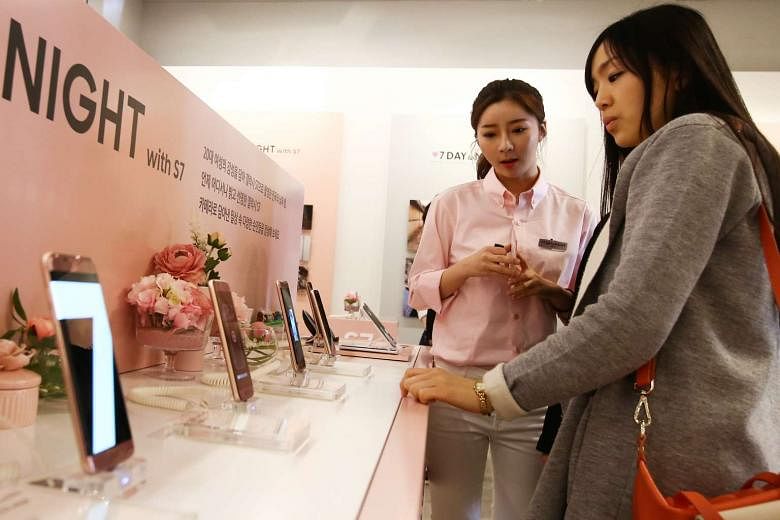SEOUL (BLOOMBERG) - Samsung Electronics posted first-quarter profit that beat analyst estimates as it capitalized on a lull in new Apple products with the early release of its Galaxy S7 smartphones.
Net income, excluding minority interests, rose to 5.26 trillion won (S$6.18 billion) in the three months ended March, the company said in a filing on Thursday (April 28). That compares with the 4.42 trillion-won average of estimates compiled by Bloomberg. Samsung also said it will buy back 2.03 trillion won worth of common and preferred shares.
Samsung priced the Galaxy S7 below its predecessor and also fixed criticisms of the earlier model to capture customers between new product releases by Apple. That helped the South Korean company withstand the impact of a global smartphone slowdown that hit prices at its semiconductor and display businesses.
"Moving up the S7 release date to March, about a month earlier than the predecessor, even at a lower price was a good strategy for Samsung," Dohoon Lee, an analyst at CIMB Securities, said in Seoul before the earnings release. "Especially when iPhone 6S demand was waning."
Apple underscored the smartphone sector's woes with its first quarterly revenue drop in more than a decade. Iphone sales fell - for the first time ever - to 51.2 million in the January-March period, from 61.2 million a year earlier. Samsung's sales rose 5.6 per cent to 49.8 trillion won during the period, compared with estimates for 48.8 trillion won.
The weaker Korean won against major currencies in the first quarter positively impacted operating profit by approximately 400 billion won, reflected mainly in the component business, Samsung said.
Shares of Samsung fell less than 1 per cent in early trading on Thursday. The stock has gained about 3 per cent this year following three straight annual declines.
Operating profit at the mobile unit rose to 3.89 trillion won from 2.74 trillion won a year earlier.Samsung revamped its strategy with the S7, releasing it in March and lowering the price. The revival of demand for the top-end model was also accompanied by strong growth in its cheaper line-ups, such as J series, said Neil Shah, research director at Counterpoint Research.
"Compared to the Galaxy S6 series performance last year, the S7 series is showing as much as 50 per cent higher sales during its opening month of sales in some markets," Counterpoint said in an April 7 report.
For the second quarter, Samsung said it anticipates solid performance, driven by steady earnings in the mobile and chip businesses plus improvement of the home appliance and display divisions. Looking ahead to the rest of 2016, the company expects the mobile, home appliance, and TV businesses to continue to generate higher earnings while focusing on stabilizing the component business in the second half.
Operating income at the chip unit was 2.63 trillion won, compared with 2.93 trillion won a year earlier as the slackening demand pressured component prices, including semiconductors and displays.
DDR3 4-gigabit dynamic random access chips averaged US$1.81 in the latest quarter, compared with US$3.42 a year earlier, according to data from inSpectrum Inc. Still, a brighter shipment outlook from rival SK Hynix this week had set a positive tone on the overall semiconductor industry.
"The market thought Samsung's second-quarter chip profit would either be flat or slightly lower than the first quarter, but SK Hynix's optimistic comment also boded well for Samsung," Claire Kim, an analyst at Daishin Securities Co., said.
The operating loss from displays was 270 billion won, compared with a profit of 520 billion won a year earlier, amid persistent price declines of liquid crystal displays.
The unit, the market leader of screens using organic light- emitting diodes for smaller devices, is in exclusive talks with Apple to supply screens for iPhone models scheduled for release next year, according to people familiar with the matter. The annual plan for capital expenditure has not yet been confirmed but is projected to increase slightly compared to last year's based on various business opportunities. Display panel spending may increase this year as the company sees strong market demand for OLED panels, it said.
Operating profit at the consumer-electronics division, which comprises TV and home appliance businesses, was 510 billion won in the quarter, reversing a loss of 140 billion won a year earlier, largely driven by higher profit from television sales amid falling panel prices.

